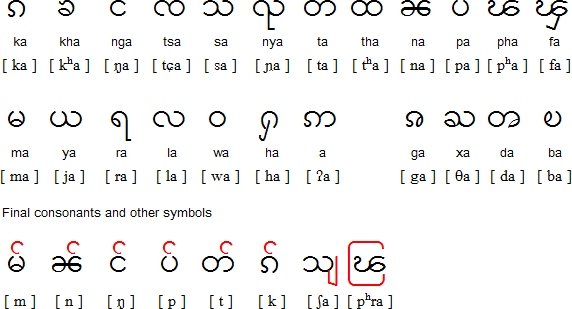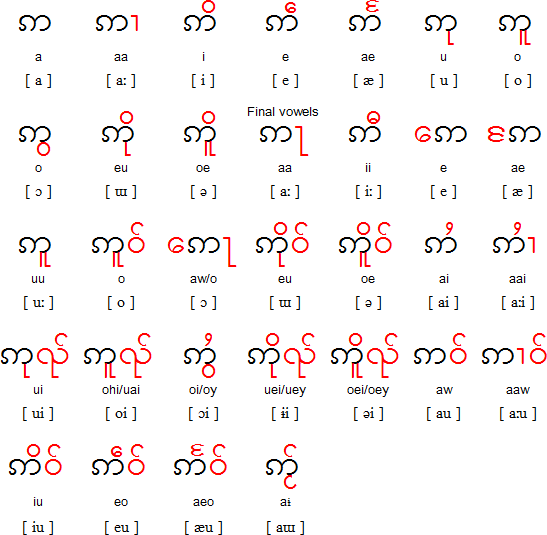RARE Beautiful language arrival! Shan Language Bibles from Thailand. A much needed Bible for this special minority.
 Shan Language Bible / the language is related to the Thai language and is called Tai-Yai, or Tai Long in the Tai languages
Shan Language Bible / the language is related to the Thai language and is called Tai-Yai, or Tai Long in the Tai languages
- PVC Bound
- Publisher:Bible Society (2000)
- ISBN-10:974905590X
- ISBN-13:978-9749055908
Buy here:
http://bibleinmylanguage.com/shan-language-bible-t...

3.3 Million speakers!

The Shan language (![]() လိၵ်ႈတႆး (helpinfo), Shan pronunciation: [lik táj](Shan written),
လိၵ်ႈတႆး (helpinfo), Shan pronunciation: [lik táj](Shan written), ![]() ၵႂၢမ်းတႆး (helpinfo), [kwáːm táj](Shan spoken), or ၽႃႇသႃႇတႆး, [pʰàːsʰàː táj]; ရှမ်းဘာသာ, [ʃáɴ bàðà]; Thai: ภาษาไทใหญ่ Thai pronunciation: [pʰaːsǎː tʰaj jàj]) is the native language of Shan people and spoken mostly in Shan State, Burma. It is also spoken in pockets of Kachin State in Burma, in northern Thailand, and decreasingly in Assam. Shan is a member of the Tai–Kadai language family, and is related to Thai. It has five tones, which do not correspond exactly to Thai tones, plus a "sixth tone" used for emphasis. It is called Tai Yai, or Tai Long in the Tai languages.
ၵႂၢမ်းတႆး (helpinfo), [kwáːm táj](Shan spoken), or ၽႃႇသႃႇတႆး, [pʰàːsʰàː táj]; ရှမ်းဘာသာ, [ʃáɴ bàðà]; Thai: ภาษาไทใหญ่ Thai pronunciation: [pʰaːsǎː tʰaj jàj]) is the native language of Shan people and spoken mostly in Shan State, Burma. It is also spoken in pockets of Kachin State in Burma, in northern Thailand, and decreasingly in Assam. Shan is a member of the Tai–Kadai language family, and is related to Thai. It has five tones, which do not correspond exactly to Thai tones, plus a "sixth tone" used for emphasis. It is called Tai Yai, or Tai Long in the Tai languages.
The number of Shan speakers is not known in part because the Shan population is unknown. Estimates of Shan people range from four million to 30 million, though the true number is somewhere around six million, with about half speaking the Shan language. In 2001 Patrick Johnstone and Jason Mandryk estimated 3.2 million Shan speakers in Myanmar; the Mahidol University Institute for Language and Culture gave the number of Shan speakers in Thailand as 95,000 in 2006. Many Shan speak local dialects as well as the language of their trading partners. Due to the civil war in Burma, few Shan today can read or write in Shan script, which was derived from the Burmese alphabet.

Shan is a Tai language spoken by about 3.3 million people in the Shan States of Burma in the northeast of the country, and also in parts of northern Thailand and in the Xishuangbanna (Sipsongpanna) Dai Autonomous Prefecture of Yunnan province in southwestern China. The language is also known as Tai-Yai, Tai-Long and ภาษาไทใหญ่.
The Shan script is used in Burma to write Shan, although few Shan speakers can read and write in the Shan script. In China a script similar to Dehong Dai (Tai Le) is used.
Notable Features
- Type of writing system: syllabic alphabet - each letter has an inherent vowel [a]. Other vowels sounds are indicated using diacritics attached to the consonants.
- Direction of writing: left to right in horizontal lines.
- Shan is a tonal language with five tones, plus a sixth which is used for emphasis.
Consonants




The Shan dialects spoken in Shan State can be divided into three groups, roughly coinciding with geographical and modern administrational boundaries, namely the northern, southern and eastern dialects. Dialects differ to a certain extent in vocabulary and pronunciation but are generally mutually intelligible. While the southern dialect has borrowed more Burmese words, Eastern Shan is somewhat closer to Northern Thai languages and Lao in vocabulary and pronunciation, and the northern so-called "Chinese Shan" is much influenced by the Yunnan-Chinese dialect. A number of words differ in initial consonants. In the north, initial /k/, /kʰ/ and /m/, when combined with certain vowels and final consonants, are pronounced /tʃ/ (written ky), /tʃʰ/ (written khy) and /mj/ (written my). In Chinese Shan, initial /n/ becomes /l/. In southwestern regions /m/ is often pronounced as /w/. Initial /pʰ/ becomes /f/ in the east.
Prominent dialects are considered as separate languages, such as Khün (called Kon Shan by the Burmese), which is spoken in Kengtung valley, and Tai Lü. Chinese Shan is also called (Tai) Mao, referring to the old Shan State of Mong Mao. 'Tai Long' is used to refer to the dialect spoken in southern and central regions west of the Salween River. There are also dialects still spoken by a small number of people in Kachin State and Khamti spoken in northern Sagaing Region.
Brown (1965) divides the three dialects of Shan as follows:
- Northern — Lashio, Burma; contains more Chinese influences
- Southern — Taunggyi, Burma (capital of Shan State); contains more Burmese influences
- Eastern — Kengtung, Burma (located in the Golden Triangle); closer to Northern Tai and Lao

Buy here:
http://bibleinmylanguage.com/shan-language-bible-t...
LEARN MORE ABOUT SHAN LANGUAGE:
Links
Information about the Shan language and alphabet
http://en.wikipedia.org/wiki/Shan_language
http://alif-shinobi.blogspot.com/2009/05/shan-alphabet.html
http://www.skyknowledge.com/shan.htm
http://www.shaninform.org
Tai-Kaidai languages
Ahom, Bouyei, Dehong Dai, Kam, Lanna, Lao, Lue, Shan, Tai Dam, Thai, Zhuang
EXPLORE POPULAR ARTICLES
A Tapestry of Scriptures: Discovering Diverse Bibles from Around the World
A Tapestry of Scriptures: Discovering Diverse Bibles from Around the WorldIn a quiet corner of the...
A Tapestry of Devotion - Diverse Bibles for a Global Congregation
A Tapestry of Devotion - Diverse Bibles for a Global CongregationIn a world rich with cultural and l...
Unveiling the Sacred: A Literary Journey Through BIML's Hungarian Bibles
Unveiling the Sacred: A Literary Journey Through BIML's Hungarian BiblesIn the vast mosaic of langua...
An Ode to the Sacred Texts: A Multilingual Journey Through the Bible's Many Tongues
An Ode to the Sacred Texts: A Multilingual Journey Through the Bible's Many TonguesIn the great tape...
Exploring Scripture Across Cultures: The Beauty of Multilingual Bibles
Exploring Scripture Across Cultures: The Beauty of Multilingual BiblesIn a world brimming with a m...
The Profound Resonance of Multilingual Bibles: A Tapestry of Faith Across Languages
The Profound Resonance of Multilingual Bibles: A Tapestry of Faith Across LanguagesIn the intricate...






